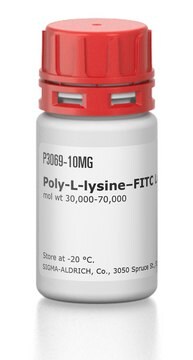P9155
Poly-ʟ-Lysine Hydrobromide
synthetic, mol wt 30,000-70,000, powder, γ-irradiated, suitable for cell culture, BioXtra
Sinônimo(s):
PDL HBr
About This Item
Produtos recomendados
Nome do produto
Poli-L-lisina, mol wt 30,000-70,000, lyophilized powder, γ-irradiated, BioXtra, suitable for cell culture
fonte biológica
synthetic (organic)
Nível de qualidade
esterilidade
γ-irradiated
linha de produto
BioXtra
Formulário
lyophilized powder
peso molecular
30,000-70,000
embalagem
pkg of 5 mg
técnica(s)
cell culture | mammalian: suitable
cobertura de superfície
4 μg/cm2
solubilidade
H2O: soluble 50 mg/mL, clear, colorless
Condições de expedição
ambient
temperatura de armazenamento
−20°C
cadeia de caracteres SMILES
Cl.NCCCCC(N)C(O)=O
InChI
1S/C18H38N6O4/c19-10-4-1-7-13(22)16(25)23-14(8-2-5-11-20)17(26)24-15(18(27)28)9-3-6-12-21/h13-15H,1-12,19-22H2,(H,23,25)(H,24,26)(H,27,28)/t13-,14-,15-/m0/s1
chave InChI
WBSCNDJQPKSPII-KKUMJFAQSA-N
Procurando produtos similares? Visita Guia de comparação de produtos
Descrição geral
Aplicação
Poly-L-lysine hydrobromide has been used to adhere the dissociated cells of cortical tissues into the culture plates. It has also been used to treat slides, to fix samples on it for immunohistochemical analysis.
Ações bioquímicas/fisiológicas
Componentes
Atenção
Nota de análise
Outras notas
Código de classe de armazenamento
11 - Combustible Solids
Classe de risco de água (WGK)
WGK 3
Ponto de fulgor (°F)
Not applicable
Ponto de fulgor (°C)
Not applicable
Equipamento de proteção individual
Eyeshields, Gloves, type N95 (US)
Escolha uma das versões mais recentes:
Já possui este produto?
Encontre a documentação dos produtos que você adquiriu recentemente na biblioteca de documentos.
Os clientes também visualizaram
Artigos
Cancer stem cell media, spheroid plates and cancer stem cell markers to culture and characterize CSC populations.
Extracellular matrix proteins such as laminin, collagen, and fibronectin can be used as cell attachment substrates in cell culture.
Nossa equipe de cientistas tem experiência em todas as áreas de pesquisa, incluindo Life Sciences, ciência de materiais, síntese química, cromatografia, química analítica e muitas outras.
Entre em contato com a assistência técnica








